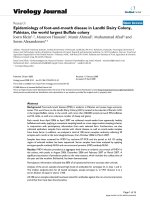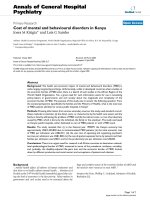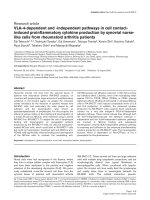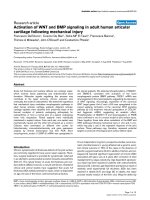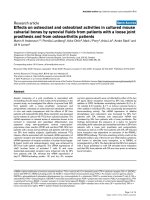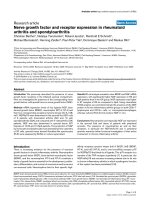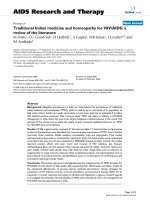Báo cáo y học: " Oral malignant melanomas and other head and neck neoplasms in Danish dogs - data from the Danish Veterinary Cancer Registry" ppt
Bạn đang xem bản rút gọn của tài liệu. Xem và tải ngay bản đầy đủ của tài liệu tại đây (208.74 KB, 6 trang )
BioMed Central
Page 1 of 6
(page number not for citation purposes)
Acta Veterinaria Scandinavica
Open Access
Research
Oral malignant melanomas and other head and neck neoplasms in
Danish dogs - data from the Danish Veterinary Cancer Registry
Louise B Brønden, Thomas Eriksen* and Annemarie T Kristensen
Address: Department of Small Animal Clinical Sciences, Faculty of Life Sciences, University of Copenhagen, Dyrlægevej 16, DK-1870 Frederiksberg
C, Denmark
Email: Louise B Brønden - ; Thomas Eriksen* - ; Annemarie T Kristensen -
* Corresponding author
Abstract
Background: Head and neck cancers (HNC) are relatively common and often very serious
diseases in both dogs and humans. Neoplasms originating in the head and neck region are a
heterogeneous group. HNC often has an unfavourable prognosis and the proximity of the tissue
structures renders extirpation of tumours with sufficient margins almost incompatible with
preservation of functionality. In humans oral malignant melanoma (OMM) is extremely rare, but
represents a particular challenge since it is highly aggressive as is the canine counterpart, which thus
may be of interest as a spontaneous animal model.
Methods: Canine cases entered in the Danish Veterinary Cancer Registry (DVCR) from May 15th
2005 through February 29th 2008 were included in this study. Fisher's exact test was used to
compare proportions of HNC in dogs and humans as well as proportions of surgically treated cases
of OMM and squamous cell carcinomas (SCC). Also the proportions of benign and malignant
neoplasms of different locations in dogs were compared using Fisher's exact test.
Results: A total of 1768 cases of neoplasias (679 malignant, 826 benign, 263 unknown) were
submitted. Of all neoplasias HNC accounted for 7.2% (n = 128). Of these, 64 (50%) were malignant
and 44 (34%) benign. The most common types of malignant neoplasia were SCC (18; 28% of
malignant), OMM (13; 20% of malignant), soft tissue sarcoma (11; 17% of malignant) and
adenocarcinoma (5; 11% of malignant). The most common types of benign neoplasms were
adenoma (7; 16% of benign), polyps (6; 14% of benign) and fibroma (5; 11% of benign).
Conclusions: In the current study, the proportion of neoplasia in the head and neck region in dogs
in Denmark was similar to other canine studies and significantly more common than in humans with
a large proportion of malignancies. Spontaneous HNC in dogs thus, may serve as a model for HNC
in humans.
Canine OMM is a spontaneous cancer in an outbred, immune-competent large mammal population
and could be a clinical model for OMM in humans.
Background
Cancer is the most common disease-associated cause of
death or euthanasia in dogs [1-5]. Cancer is equally fre-
quent in human medicine, where the age-standardised
incidence rates in Denmark in 2004 were 697 and 605 per
100.000 for males and females, respectively [6].
Published: 18 December 2009
Acta Veterinaria Scandinavica 2009, 51:54 doi:10.1186/1751-0147-51-54
Received: 22 May 2009
Accepted: 18 December 2009
This article is available from: />© 2009 Brønden et al; licensee BioMed Central Ltd.
This is an Open Access article distributed under the terms of the Creative Commons Attribution License ( />),
which permits unrestricted use, distribution, and reproduction in any medium, provided the original work is properly cited.
Acta Veterinaria Scandinavica 2009, 51:54 />Page 2 of 6
(page number not for citation purposes)
Humans and dogs share a common environment and can-
cer in dogs has been proposed as a model of cancer in man
[7-12]. It has been argued that the dog may represent a
valuable model of cancer in humans and work as a senti-
nel of environmental carcinogens [12-14]. Dogs experi-
ence neoplasias to the same extent as humans despite
their relatively shorter life span which may allow for accel-
erated investigations of environmental influences in the
disease aetiology. Previous studies have shown that dogs
react to environmental carcinogens in the same manner as
humans. An association between environmental tobacco
smoke and increased incidence of cancer in the nasal cav-
ity and paranasal sinuses has been ascertained [11,15]. In
addition, dogs in urban zones have been shown to be at
risk of tonsillar carcinoma compared to dogs in rural
zones [10]. Furthermore, in some cases, higher frequency
of specific neoplastic diseases in dogs compared to
humans offers an opportunity readily to investigate types
of neoplasia rarely seen in humans. Dogs constitute a
potentially more relevant clinical model with spontane-
ous neoplasms occurring in an outbred immuno-compe-
tent large mammal compared to the traditional
experimental animal setting [13]. Spontaneous cancers in
dogs, such as osteosarcomas and transitional cell carcino-
mas, have already been recognised to share traits like bio-
logical behaviour and therapeutic response with their
human counterparts [12,16-18].
Head and neck cancers (HNC) are relatively common and
often very serious diseases in both dogs and humans
[6,19]. The incidence of human HNC in Denmark has
increased during the last 20 years [6]. According to data
from The Danish Cancer Registry; HNC represented 1178
(3.4%) out of a total of 35052 new cancer cases diagnosed
in 2004 [6] while Hoffman et al. [20] reported that HNC
accounted for 6.6% of cases reported to the National Can-
cer Data Base in the United States. Neoplasias originating
in the head and neck region constitute a heterogeneous
group with various anatomical locations and a wide spec-
trum of histopathological diagnoses. Regardless of this,
HNC in humans are typically approached as one group
partly due to the similar therapeutic approach in these
tumours.
HNC often has an unfavourable prognosis due to the high
proportion of malignant and invasive neoplasms. The
proximity of the tissue structures renders extirpation of
tumours with sufficient margins almost incompatible
with preservation of functionality [21]. In humans oral
malignant melanoma (OMM) represents a particular
challenge since it is highly aggressive. Canine OMM is
more frequent but share similar characteristics with
human OMM and may thus be of interest as a spontane-
ous animal model [13,22]. Surgery is the treatment of
choice in most of the neoplasms seen in HNC, but radio-
therapy, chemotherapy and immunotherapy are also used
when appropriate. Vital structures make radiation therapy
(RT) difficult and treatment includes the risk of irradia-
tion mucositis [23]. Chemotherapy is effective only
against very few HNC, such as lymphoma [19]. Recent
studies of immunotherapy have shown promising results
in the treatment of canine OMM [13,22].
The objective of the current study was to describe the
occurrence, biological behaviour, location, type and treat-
ment of HNC in dogs registered in the Danish Veterinary
Cancer Registry (DVCR). Furthermore the findings were
compared to other registry studies in dogs and humans
and the use of HNC in dogs as a model for HNC in
humans was discussed, with special focus on OMM.
Materials and methods
Canine cases entered in the DVCR from May 15
th
2005
through February 29
th
2008 were included in this study.
The DVCR is a database of cases of neoplasia in Danish
dogs and cats. It is an incident registry where each neo-
plasm is regarded as a separate entity, and data are col-
lected prospectively. In contrast to other veterinary and
human cancer registries DVCR comprises both benign
and malignant neoplasms, and neoplasms diagnosed
using other diagnostic methods than histology, such as
cytology, diagnostic imaging etc.
Data were submitted using a web based submission form
with an interface consisting of a questionnaire, in which
veterinarians supplied data regarding the animal (i.e. age,
gender, breed, postal code) and the neoplasm (i.e. type,
behaviour, location, diagnostic approach). Cases were
submitted from both small primary clinics and large refer-
ral hospitals and from clinics both from the capital region,
larger cities as well as from rural areas of Denmark. The
therapy utilised and cancer related euthanasia was also
registered. The registration form was created based on the
human cancer registry interface in order to facilitate later
comparison and most variables are entered using drop-
down menus for instant coding of data. Multiple neo-
plasms in a single individual were reported separately or
manually separated if reported in bulk before evaluation
took place.
Inclusion criteria
Following the classification of HNC in the Danish Human
Cancer registry (ICD 10) [6,24], cases of neoplasia sub-
mitted to DVCR located in the eyelid, oral cavity, oro- and
nasopharynx, lip, tongue, nasal and sinus cavities, ear, sal-
ivary or thyroid gland were included in the current study.
Cases of neoplasia with neoplasms located in the eye,
brain and skin of the head and neck including the pinna
were excluded.
Acta Veterinaria Scandinavica 2009, 51:54 />Page 3 of 6
(page number not for citation purposes)
Data was entered into an excel spreadsheet (Microsoft
Office Excel) and statistical tests performed in SAS vs. 9.1
(SAS Institute, Cary, NC, USA). Fisher's exact test was used
to compare proportions of HNC in dogs and humans as
well as evaluation of the proportions of surgically treated
cases of OMM and squamous cell carcinomas (SCC), the
proportion of humans and dogs that were treated with
surgery of all HNC. Also the proportions of benign and
malignant in different locations of neoplasms in dogs
were compared using Fisher's exact test.
Results
During the study period a total of 1768 cases of neoplasia
(679 malignant, 826 benign, 263 unknown) were submit-
ted to the DVCR. Head and neck cancer accounted for
7.2% (n = 128) of these. Of the 128 HNC cases, 64 (50%)
were malignant and 44 (34%) benign. In 20 (18%) cases
no behaviour was submitted. If only malignant neoplasm
were regarded, 9.3% of the total number of neoplasms
was HNC. Sixty-eight neoplasms came from males (62
entire, 6 neutered), whereas 60 came from females (43
entire, 17 neutered) resulting in a male to female ratio
(M:F) of 1.13, not only when considering all neoplasms,
but also if only malignant neoplasms were included. The
most common locations of HNC were the oral cavity, eye-
lids, the nasal cavity, lips and the thyroid gland which
together accounted for 92% of the total number of HNC
in the DVCR (Table 1). The majority of HNC were located
in the oral cavity (46%) and 51% of these were malignant
(Table 1). There was a significantly higher proportion of
malignant than benign neoplasms in the nasal cavity and
the thyroid gland compared to any of the other locations.
In contrast there were significantly more benign neo-
plasms located in the eyelid than in other of the locations
(P < 0.001).
The most common types of malignant neoplasia were
SCC (18; 28% of malignant), OMM (13; 20% of malig-
nant), soft tissue sarcoma (11; 17% of malignant) and
adenocarcinoma (5; 11% of malignant). The most com-
mon types of benign neoplasms were adenoma (7; 16% of
benign), polyps (6; 14% of benign) and fibroma (5; 11%
of benign) (Table 2).
Surgery was the most commonly used treatment of the
HNC in dogs and was used in 74 (58%) of all cases (Table
3). Of these, two dogs had adjunctive therapy. One dog
was treated with corticosteroids and one was treated with
chemotherapy. Three dogs received only medical therapy
in the form of corticosteroids. Dogs with OMM were
treated with surgery in 11 cases (73%), whereas dogs with
SCC were treated with surgery in only 3 cases (14%).
Euthanasia was chosen in 30 cases of this study, two fol-
lowing surgery. Twenty-four of the 30 euthanised dogs
had malignant neoplasms, which equals 38% of the dogs
with malignant neoplasms.
Oral malignant melanoma
OMM was the second most common neoplasm in the
head and neck region. Metastases were found in 5 out of
13 (38%) cases. Surgery was performed significantly more
often in OMM cases than in cases of SCC (P < 0.0001).
Chemotherapy was not used in any OMM cases. In 4
cases, euthanasia was chosen, one of these following sur-
gery. Table 4 offers an overview of the OMM cases includ-
ing information about grade if known, metastases and
treatment, all data were extracted directly from the DVCR.
Discussion
The overall occurrence of HNC in the DVCR was 7.2% and
if only malignant neoplasms were regarded, 9.3%. The
malignant proportion was higher than in previous veteri-
nary reports (4.2 to 6.3%) [25-29] as well as reports in
humans (3.4 to 6.6%) [6,20,30]. The gender distribution
was more equal in the current study than seen in other vet-
erinary and human studies (M:F ratios from 1.50 to1.71)
where males were more frequently represented than
females [6,20,25,31]. In the current study, the proportion
of malignant neoplasms (50%) was higher than in a Nor-
wegian veterinary study (34%) [25]. The lower degree of
malignancy in Norwegian HNC was due to a low propor-
tion of malignancies in neoplasms of the oral cavity
(31%). No other large studies included benign neo-
plasms, thus comparative data are scarce. The inclusion
criteria of the DVCR comprising histopathological, cyto-
logical and clinical diagnostics and both benign and
malignant neoplasms, contribute to the relatively high
proportions in this study. Comparisons of various cancer
registries thus, need to take variations in inclusion criteria
Table 1: Anatomical location and biological behaviour of head and neck cancer in Danish dogs.
Benign
No (pct across)
Malignant
No (pct across)
Unknown
No (pct across)
Total
No (pct of total)
Oral cavity 17 (29%) 30 (51%) 12 (20%) 59 (46%)
Eyelid 17 (94%) 1 (6%) 2 (11%) 18 (14%)
Nasal cavity 0 (0%) 16 (89%) 2 (11%) 18 (14%)
Lip 6 (40%) 8 (53%) 1 (7%) 15 (12%)
Thyroid gland 0 (0%) 5 (63%) 3 (38%) 8 (6%)
Acta Veterinaria Scandinavica 2009, 51:54 />Page 4 of 6
(page number not for citation purposes)
into consideration. The DVCR is a prospective incidence
registry based on record entries from all cases of neo-
plasms from all animals in a defined population. The
DVCR has been validated against medical records with a
high proportion (>95%) of agreement of key variables
[32].
Similar to the present study, previous veterinary studies
have reported the oral cavity as the most common loca-
tion of HNC, accounting for 69% to 88% of the total HNC
cases [24,26]. In humans the most prevalent sites include
the oral cavity (18 to 24.6% of the cases) and larynx
(20.8% to 28.5%) [6,20,31]. In the current study no cases
were located in the larynx. Cancers of the larynx in
humans are strongly associated with repeated exposure to
cigarette smoke and alcohol [33,34]. The nasal cavity
accounted for more cases in the current study (14%) com-
pared to other veterinary (4.4 to 6.1%) as well as human
studies (5.1%) [6,25,26]. A previous study showed a con-
nection between increased prevalence of nasal tumours
and passive smoking in dogs [10].
More than half of the HNC cases (55.8%) in humans were
SCC originating in the larynx and the oral cavity. Other
common types of HNC reported in humans are adenocar-
cinomas and lymphomas [20,31]. In humans the most
common types of malignant neoplasms were SCC, aden-
ocarcinoma and lymphoma [20]. Squamous cell carci-
noma was predominant in both dogs and humans, but
soft tissue sarcoma and malignant melanoma were more
frequent in dogs than humans.
A standardised treatment scheme is not available for all
types of HNC, but surgery remains the primary therapeu-
tic modality in dogs in Denmark. However adjunctive
treatment e.g. RT is increasingly being added to the treat-
ment protocols [35]. In humans, RT is more widely uti-
lised, 25.0 to 26.8% of the cases in humans were treated
with both surgery and RT, and 18.9 to 29.5% were treated
with RT alone, while surgery as a sole treatment was used
in 32.4 to 34.2% of the cases [20,31]. RT was not used in
any of the cases in the current study. This type of therapy
is at this point not readily available to veterinary patients
in Denmark, and when available very few owners choose
to take advantage of this modality.
OMM as an example of dogs serving as models for OMM
in humans
Studies into aetiology, risk factors and treatment response
may be conducted faster and include more individuals if
performed in dogs instead of people. Spontaneously
occurring types of neoplasia commonly found in dogs but
rarely in humans have the potential to be exerted as mod-
els of cancer in humans. A phenotypically well character-
ised highly prevalent spontaneous canine model for rare
human cancers opens the possibility for in vivo research
with a short interval between generations.
The proportion of HNC of all tumours in dogs in DVCR
was significantly higher than the proportion of humans
with HNC in Denmark (P < 0.0001) [6] which was also
Table 2: Most common malignant and benign neoplasms in the head and neck region of dogs.
Malignant neoplasms Number
(pct of total)
Pct. of total malignant or benign
Squamous cell carcinoma 18 (14%) 28%
Melanoma 13 (10%) 20%
Soft tissue sarcoma 11 (9%) 17%
Adenocarcinoma 5 (4%) 11%
Benign neoplasms
Adenoma, sebaceous 7 (5%) 16%
Polyps 6 (5%) 14%
Fibroma 5 (4%) 11%
Histiocytoma 3 (2%) 7%
Papilloma 3 (2%) 7%
Epulis 3 (2%) 7%
Table 3: Verification of neoplasm and treatment for the different
groups of biological behaviour
Verification Surgery Benign Malignant Uknown
Cytology No surgery 2 19 4
Surgery 5 5 4
Histology No surgery 1 20 4
Surgery 35 19 5
Other No surgery 1 1 2
Surgery 0 0 1
Total (pct surgery) 128 (58%) 44 (91%) 64 (38%) 20 (50%)
Acta Veterinaria Scandinavica 2009, 51:54 />Page 5 of 6
(page number not for citation purposes)
evident when compared to other studies [36,37]. In dogs
SCC and OMM were the most commonly reported types
of HNC both in the current and other veterinary studies
[38,39]. OMM accounted for 20% to 50% of oral malig-
nancies in other veterinary studies, similar to the current
study [13,27,40]. However in humans, primary OMM is
extremely rare [20,36,41] and often bears a poor progno-
sis with a 5 year survival of 12.3% to 17.2% and metas-
tases are frequently observed [36,42]. Dogs equally have
short life expectancies following a diagnosis of OMM and
in one study distant metastasis were found at necropsy in
47% to 67% of the OMM cases, consistent with the cur-
rent study [38].
The similarities in biological behaviour, treatment
response and severity of canine OMM suggest dogs could
make an interesting and relevant model for OMM in
humans [43]. Spontaneous canine cancers may serve as an
important bridge between preclinical studies in mouse
model systems and clinical trials in humans with cancer
and support the synergy of collaborations between veteri-
nary and human cancer centers [22]. Such collaboration
has already resulted in the development of an immuno-
therapy in dogs with grade II OMM and has shown prom-
ising results [44]. This type of treatment is also being
investigated in humans [45,46]. The use of spontaneously
developing cancer in the companion animal population
could potentially lower the number of experimental ani-
mals needed in research, in line with the Three R's concept
(Replacement, Reduction, Refinement) [47]. Furthermore
dogs provide a more faithful preclinical therapeutic
model compared to the traditional mouse systems as both
biological behaviour and response to treatment are simi-
lar to those seen in humans [22,43]. And importantly,
dogs may also benefit from being models as the latest
treatment options would be made available to them in a
clinical trial setting.
Conclusions
In the current study the proportion of neoplasia in the
head and neck region in dogs in Denmark was similar to
other canine studies and significantly more common than
in humans, with a large proportion of malignancies, and
a slight overweight of males.
This suggests that spontaneous HNC in dogs may serve as
a model for HNC in humans. Canine OMM would be a
more faithful preclinical model for OMM in humans
compared with the more traditional mouse systems.
OMM in canines is a spontaneous cancer in an outbred,
immune-competent large mammal population that
shares the environment of humans.
Competing interests
The authors declare that they have no competing interests.
Authors' contributions
LBB carried out data management and statistical analysis,
participated in designing thestudy, evaluating results,
researching background literature and drafting the manu-
script. TE participated in designing the study, evaluating
results, researching background literature and drafting the
manuscript. ATK supplied the foundation and idea for the
study as well as participated in coordination and drafting
the manuscript. All authors read and approved the final
manuscript.
Acknowledgements
The authors would like to thank the veterinarians at the clinics and hospi-
tals who have participated and submitted cases of neoplasia to the DVCR.
References
1. Arnesen K, Gamlem H, Glattre E, Moe L, Nordstoga K: Registration
of canine cancer [in Norwegian]. Tidsskr Nor Laegeforen 1995,
115:714-717.
2. Bonnett BN, Egenvall A, Olson P, Hedhammar A: Mortality in
insured Swedish dogs: rates and causes of death in various
breeds. Vet Rec 1997, 141:40-44.
Table 4: Overview of 13 cases of oral malignant melanoma including grade if provided, metastases and if surgery was performed.
Case Grade Regional lymph node metastases Distant metastases Surgery performed
1II No No Yes
2III Yes No Yes
3 III Yes Yes Yes
4 Unknown No No Yes
5 Unknown No Unknown Yes
6 Unknown No Unknown Yes
7 Unknown No Unknown Yes
8 Unknown No Unknown No
9 Unknown Yes No No
10 Unknown Yes No Yes
11 Unknown Unknown No Yes
12 Unknown Unknown Unknown No
13 Unknown Unknown Unknown Yes
Acta Veterinaria Scandinavica 2009, 51:54 />Page 6 of 6
(page number not for citation purposes)
3. Eichelberg H, Seine R: Life expectancy and cause of death in
dogs. I. The situation in mixed breeds and various dog breeds
[in German]. Berl Münch Tierärzl Wochenschr 1996, 109:292-303.
4. Proschowsky HF, Rugbjerg H, Ersboll AK: Mortality of purebred
and mixed-breed dogs in Denmark. Prev Vet Med 2003,
58:63-74.
5. Walter JH, Schwegler K: The frequency of neoplasms in dogs
dissected in Berlin [in German]. Zentralbl Veterinarmed A 1992,
39:328-341.
6. Danish National Board of Health: Cancer incidence in Denmark.
[in Danish]. 2008, 12(4):.
7. Buck WB: Animals as monitors of environmental quality. Vet
Hum Toxicol 1979, 21:277-284.
8. Garbe PL: The companion animal as a sentinel for environ-
mentally related human diseases. Acta Vet Scand Suppl 1988,
84:290-292.
9. Glickman LT, Schofer FS, McKee LJ, Reif JS, Goldschmidt MH: Epide-
miologic study of insecticide exposures, obesity, and risk of
bladder cancer in household dogs. J Toxicol Environ Health 1989,
28:407-414.
10. Reif JS, Cohen D: The environmental distribution of canine res-
piratory tract neoplasms. Arch Environ Health 1971, 22:136-140.
11. Reif JS, Dunn K, Ogilvie GK, Harris CK: Passive smoking and
canine lung cancer risk. Am J Epidemiol 1992, 135:234-239.
12. Vail DM, MacEwen EG: Spontaneously occurring tumors of
companion animals as models for human cancer. Cancer Invest
2000, 18:781-792.
13. Bergman PJ, Camps-Palau MA, McKnight JA, Leibman NF, Craft DM,
Leung C, Liao J, Riviere I, Sadelain M, Hohenhaus AE, Gregor P,
Houghton AN, Perales MA, Wolchok JD: Development of a xeno-
geneic DNA vaccine program for canine malignant
melanoma at the Animal Medical Center. Vaccine 2006,
24:4582-4585.
14. MacEwen EG: Spontaneous tumors in dogs and cats: models
for the study of cancer biology and treatment. Cancer Metas-
tasis Rev
1990, 9:125-136.
15. Reif JS, Bruns C, Lower KS: Cancer of the nasal cavity and para-
nasal sinuses and exposure to environmental tobacco smoke
in pet dogs. Am J Epidemiol 1998, 147:488-492.
16. Hayes HM Jr: The comparative epidemiology of selected neo-
plasms between dogs, cats and humans. A review. Eur J Cancer
1978, 14:1299-1308.
17. Hayes HM Jr, Hoover R, Tarone RE: Bladder cancer in pet dogs:
a sentinel for environmental cancer? Am J Epidemiol 1981,
114:229-233.
18. Knapp DW, Waters DJ: Naturally occurring cancer in pet dogs:
important models for developing improved cancer therapy
for humans. Mol Med Today 1997, 3:8-11.
19. Withrow SJ, Vail DM: Withrow and MacEwen's Small Animal Clinical
Oncology St. Louis, Missouri: Saunders; 2007.
20. Hoffman HT, Karnell LH, Funk GF, Robinson RA, Menck HR: The
National Cancer Data Base report on cancer of the head and
neck. Arch Otolaryngol Head Neck Surg 1998, 124:951-962.
21. Meler E, Dunn M, Lecuyer M: A retrospective study of canine
persistent nasal disease: 80 cases (1998-2003). Can Vet J 2008,
49:71-76.
22. Bergman PJ, McKnight J, Novosad A, Charney S, Farrelly J, Craft D,
Wulderk M, Jeffers Y, Sadelain M, Hohenhaus AE, Segal N, Gregor P,
Engelhorn M, Riviere I, Houghton AN, Wolchok JD: Long-term sur-
vival of dogs with advanced malignant melanoma after DNA
vaccination with xenogeneic human tyrosinase: a phase I
trial. Clin Cancer Res 2003, 9:1284-1290.
23. Collen EB, Mayer MN: Acute oropharyngeal effects of full-
course radiation treatment of tumors of the head. Can Vet J
2008, 49:509-512.
24. World Health Organization: International Classification of Dis-
eases (ICD). 2009. 15-3-2009
25. Arnesen K, Gamlem H, Glattre E, Grøndalen J, Moe L, Nordstoga K:
The Norwegian Canine Cancer Register 1990-1998. Report
from the project "Cancer in the Dog". Eur J of Compan Anim
Pract 2001, XI:159-169.
26. Bastianello SS: A survey on neoplasia in domestic species over
a 40-year period from 1935 to 1974 in the Republic of South
Africa. VI. Tumours occurring in dogs. Onderstepoort J Vet Res
1983, 50:199-220.
27. Bostock DE, Curtis R: Comparison of canine oropharyngeal
malignancy in various geographical locations. Vet Rec 1984,
114:341-342.
28. Dorn CR, Taylor DO, Schneider R, Hibbard HH, Klauber MR: Sur-
vey of animal neoplasms in Alameda and Contra Costa
Counties, California. II. Cancer morbidity in dogs and cats
from Alameda County. J Natl Cancer Inst 1968, 40:307-318.
29. Merlo DF, Rossi L, Pellegrino C, Ceppi M, Cardellino U, Capurro C,
Ratto A, Sambucco PL, Sestito V, Tanara G, Bocchini V: Cancer Inci-
dence in Pet Dogs: Findings of the Animal Tumor Registry of
Genoa, Italy. J Vet Intern Med 2008, 22:976-984.
30. Cancer in Norway 2006 - Cancer incidence, mortality, sur-
vival and prevalence in Norway. Edited by: Bray F. Oslo, Cancer
Registry of Norway; 2009.
31. Carvalho AL, Nishimoto IN, Califano JA, Kowalski LP: Trends in
incidence and prognosis for head and neck cancer in the
United States: a site-specific analysis of the SEER database.
Int J Cancer 2005, 114:806-816.
32. Brønden LB, Lindstrand S, Nielsen SS, Toft N, Kristensen AT: Vali-
dation of data collected in the Danish Veterinary Cancer
Registry. Vet Comp Oncol 2009, 7:207-11.
33. Pelucchi C, Gallus S, Garavello W, Bosetti C, La VC: Cancer risk
associated with alcohol and tobacco use: focus on upper
aero-digestive tract and liver. Alcohol Res Health 2006,
29:193-198.
34. Pelucchi C, Gallus S, Garavello W, Bosetti C, La VC: Alcohol and
tobacco use, and cancer risk for upper aerodigestive tract
and liver. Eur J Cancer Prev 2008, 17:340-344.
35. King GK, Bergman PJ, Harris D: Radiation oncology of head and
neck tumors. Vet Clin North Am Small Anim Pract 1997, 27:101-113.
36. Meleti M, Leemans CR, Mooi WJ, Vescovi P, van d WI: Oral malig-
nant melanoma: a review of the literature. Oral Oncol 2007,
43:
116-121.
37. Rapidis AD, Apostolidis C, Vilos G, Valsamis S: Primary malignant
melanoma of the oral mucosa. J Oral Maxillofac Surg 2003,
61:1132-1139.
38. Oakes MG, Lewis DD, Hedlund CS, Hosgood G: Canine Oral Neo-
plasia. Compend Contin Educ Vet 1993, 15:15-31.
39. Bergman PJ: Canine oral melanoma. Clin Tech Small Anim Pract
2007, 22:55-60.
40. Ramos-Vara JA, Beissenherz ME, Miller MA, Johnson GC, Pace LW,
Fard A, Kottler SJ: Retrospective study of 338 canine oral
melanomas with clinical, histologic, and immunohistochem-
ical review of 129 cases. Vet Pathol 2000, 37:597-608.
41. Sortino-Rachou AM, Cancela MC, Voti L, Curado MP: Primary oral
melanoma: population-based incidence. Oral Oncol 2009,
45:254-258.
42. Meleti M, Leemans CR, de BR, Vescovi P, Sesenna E, van d WI: Head
and neck mucosal melanoma: experience with 42 patients,
with emphasis on the role of postoperative radiotherapy.
Head Neck 2008, 30:1543-1551.
43. MacEwen EG: Spontaneous tumors in dogs and cats: models
for the study of cancer biology and treatment. Cancer Metas-
tasis Rev 1990, 9:125-136.
44. Bergman PJ: Anticancer vaccines. Vet Clin North Am Small Anim
Pract 2007, 37:1111-1119.
45. Kirkwood JM, Lee S, Moschos SJ, Albertini MR, Michalak JC, Sander
C, Whiteside T, Butterfield LH, Weiner L: Immunogenicity and
antitumor effects of vaccination with peptide vaccine +/-
granulocyte-monocyte colony-stimulating factor and/or
IFN-alpha2b in advanced metastatic melanoma: Eastern
Cooperative Oncology Group Phase II Trial E1696. Clin Can-
cer Res 2009, 15:1443-1451.
46. Wolchok JD, Livingston PO: Vaccines for melanoma: translating
basic immunology into new therapies. Lancet Oncol 2001,
2:205-211.
47. Russell WMS, Burch RL: The Principles of humane experimental tech-
nique London: Universities Federation for Animal Welfare; 1959.


